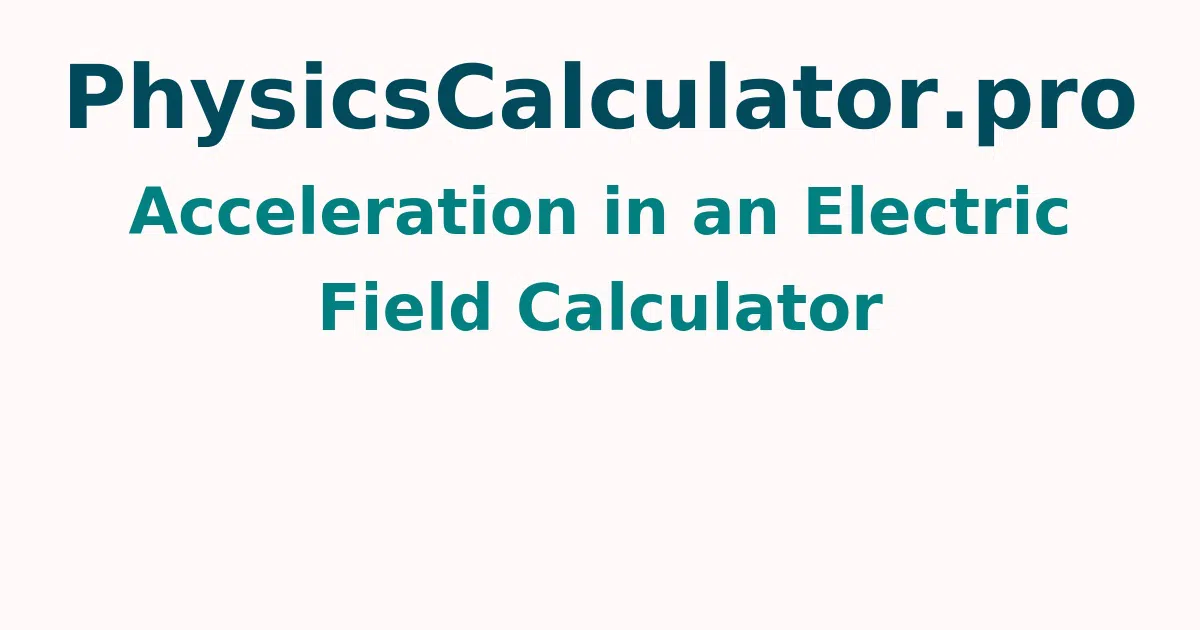Acceleration in an Electric Field Calculator
The Calculator for Acceleration in an Electric Field can be a useful tool for calculating the acceleration of a charged particle in an electric field. Enter the values for mass, charge, and electric field strength, and our calculator will calculate everything for you in a fraction of a second.
Acceleration in the Electric Field Formula
We can readily determine the acceleration of a particle if we know its mass. The formula a = q x E/m can be used to do this
- Where, a = acceleration of a particle
- q = particle charge
- m = mass of a particle
- E = electric field strength
Electric Field Acceleration Derivation
- Using Newton's Second Law, i.e. F = ma, we can calculate the acceleration in the electric field. The acceleration can be calculated using this equation: a = F/m, where F is the force and m is the mass.
- The formula for Force in terms of electric fields and particles is F = q x E, where q is the charge and E is the Electric Field Strength.
- q x E=m x a is the result of equating both force values.
- By rearranging the equations, we get a = q x E/m, which is the formula for acceleration in an electric field.
- If you simplify the equation, even more, you can easily calculate the capacitance of parallel plates.
How to Calculate Electric Field Acceleration
Follow the steps outlined below to determine the electric acceleration in no time.
- Before starting, determine the charge, particle mass, and electric field strength.
- Substitute the input values into the Electric Acceleration formula, a = q x E / m.
- To get the acceleration in the electric field, simplify the equation even more.
For more concepts check out physicscalculatorpro.com to get quick answers by using this free tool.
How to Use the Electric Field Acceleration Calculator?
The following is the procedure explaining how to use the electric field calculator
- Step 1: In the input field, enter the unknown mass, charge, electric field strength, and x.
- Step 2: Now press the "Calculate x" button to obtain the region enclosed by charged particles.
- Step 3: Finally, in the output field, the electric field for the provided force and charge will be presented.
Examples of Electric Field Acceleration
Question 1: In a homogeneous electric field of magnitude 2.00 x 10^4 N /C, one electron is emitted from the rest. Calculate the electron's acceleration.
Solution:
Given:
E = 3.00 x 10^4 N /C
As we know, q = 1.602 x 10^-19 C, m = 9.11 x 10^-31 kg
F = qE = (1.602 x 10^-19 C)(3.00 x 10^4 N /C)
F = 4.806 x 10^-15 N
a = F/m = (4.806 x 10^-15 N)/(9.11 x 10^-31 kg)
a = 5.27 x 10^15 m/s^2.
FAQs on Electric Field Acceleration Calculator
1. What is the definition of an electric field acceleration?
The overall acceleration of a particle due to the force of an electric field is defined as acceleration in an electric field.
2. Do electrons accelerate in an electric field?
The steady applied electric field that results from the external potential difference between two sites accelerates electrons, but the intense internal electric fields generated by the material atoms that make up the circuit decelerate them.
3. Which field can accelerate an electron without changing its speed?
An electron can be accelerated but not changed in speed by a magnetic field. The magnetic field does not affect the speed since it applies a force that is orthogonal to the velocity.
4. What are the 2 best examples of acceleration?
The following are some good examples of acceleration in everyday life
- When the automobile accelerates.
- When the car starts to slow down
5. Is the magnetic field perpendicular to acceleration?
The cross product of two vectors always has the same direction as the two vectors. As a result, the direction of force is perpendicular to the velocity, and hence the direction of acceleration is perpendicular to the magnetic field direction.
